|

May 12, 2017
from
MessageToEagle Website
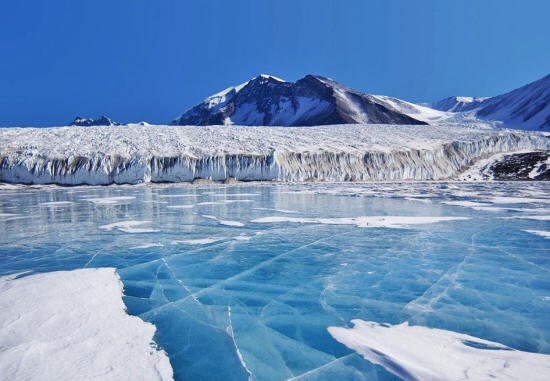
If you have suspected there is something hidden beneath the thick
ice
of Antarctica, then you were
absolutely right.
Scientists have discovered giant landforms, known as "eskers"
lurking beneath the ice. Some of these massive landforms are five
times bigger than those seen in regions where ancient ice has
retreated, and researchers say they're shaping the ice hundreds of
miles away.
Researchers have long suspected there are landforms beneath
Antarctica, but the thick ice prevent us from observing what is
hidden thousands of feet below.
Now, using satellite imagery and airborne and ground-based radar
data, researchers from the Université libre de Bruxelles in
Belgium and the Bavarian Academy of Sciences in Germany have
detected distinct 'radar reflectors' below
King Baudouin Ice Shelf in Dronning
Maud Land, Antarctica.
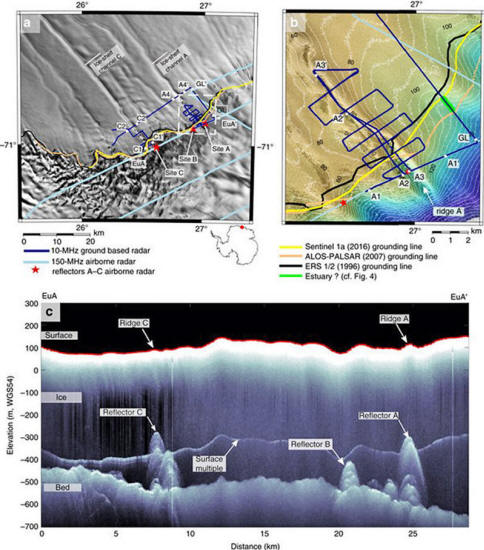
(a) Location of airborne (2011) and ground-based
(2016) radar profiles of the King Baudouin Ice
Shelf, East Antarctica, with Landsat image in the
background. Grounding lines are marked for 1996,
2007 and 2016. The dashed white box delineates the
area in b where radar-profile locations are shown
with TanDEM-X surface elevation (5 m contours).
(c) Airborne radar profile EuA-EuA′ covering the
grounded ice sheet. Internal reflection hyperbolas
reaching hundreds of meters above the ice-bed
interface are evident (reflectors A-C), and are
aligned with ice-shelf channels located seawards
(into page). Reflectors A and C are beneath surface
ridges.
Image credit: Nature Communications
These are subglacial conduits that form under large ice sheets as
part of their basal hydrological system.
These tunnels have a
typical diameter of several meters to tens of meters, and they
funnel the subglacial melt water towards the ocean.
'Eskers, a glacial
landform used in the reconstruction of palaeo ice sheets, are
the depositional evidence of former channelized subglacial
hydrological systems,' the authors wrote in the study (Actively
evolving subglacial conduits and eskers initiate ice shelf
channels at an Antarctic grounding line), published
to Nature Communications.
'Our inferred eskers are much larger than most eskers of the
Wisconsonian glacial record, but, their shape resembles that of
some eskers in deglaciated areas formerly occupied by
marine-terminating ice sheets.'
As the ice flows over
these ridges, they leave 'scars' along the bottom of the ice.
The landforms are comparable in height with the Eiffel tower and
researchers admit they have not seen anything like this before.
It was originally thought that ice-shelf channels are carved by
melting due to the ocean only, but this seems only part of the
story.
"Our study shows that
ice-shelf channels can already be initiated on land, and that
the size of the channels significantly depends on sedimentation
processes occurring over hundreds to thousands of years"
indicates Reinhard Drews, lead author of the study.
This is perhaps not the
ancient lost civilization of Antarctica some think is
buried beneath the ice, but it's still a significant discovery that
can help to unravel some of the mysteries of our coldest continent.
We should also keep in mind that the discover of these hidden eskers
is of interest for the stability of the floating ice shelves, as
numerous studies show that ice shelf thinning has major consequences
for ice sheet stability.
It's also important to study Antarctica because this mysterious
continent could help us answering questions such as:
Antarctica holds the
secrets to Mankind's Past and Future...
Antarctica Holds the Secrets to...
Mankind's Past and Future
February 27,
2015
from
MessageToEagle Website
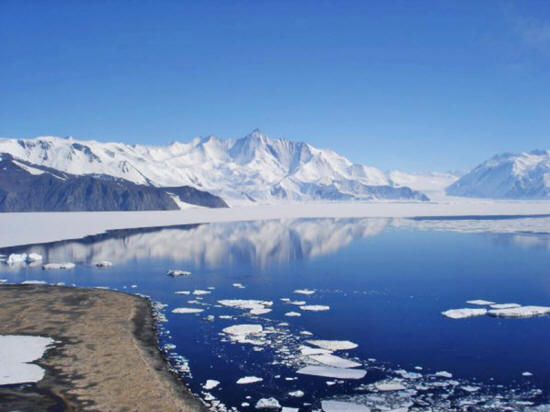
Mt.
Herschel, Antarctica.
Antarctica, is one of the most mysterious continents on our planet.
It is wildest, most
desolate and mysterious of all our continents. Clues to answering
humanity's most basic questions are locked in this continental
freezer the size of the United States and half of Canada.
Antarctica could also
help us answering questions such as:
Ever since the first
explorers set foot in Antarctica 194 years ago, the continent has
been regarded as treasure chest for scientists trying to determine
everything from the creation of the cosmos to how high seas will
rise with
global warming.
Antarctica - Mystery continent holds key to mankind's future
"It's a window
out to the universe and in time," said Kelly Falkner, polar
program chief for the U.S. National Science Foundation.
For a dozen days in
January, in the middle of the chilly Antarctic summer, The
Associated Press
followed scientists from
different fields searching for,
-
alien-like
creatures
-
hints of
pollution trapped in ancient ice
-
leftovers
from the Big Bang
-
biological
quirks that potentially could lead to better medical
treatments
-
signs of
unstoppable melting
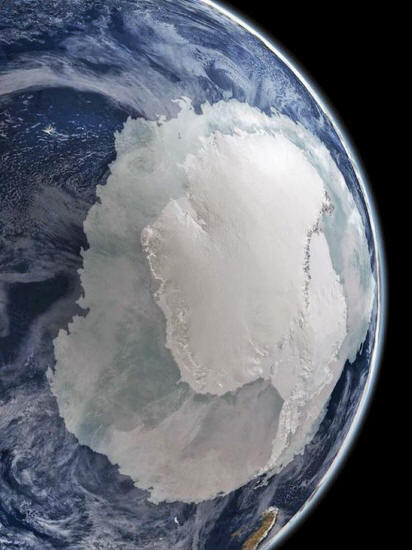
Antarctica seen from space.
Image credit: NASA
The journey on a Chilean navy ship along the South Shetland
islands and vulnerable Antarctic Peninsula, which juts off the
continent like a broken pinky finger, logged 833 miles (1,340
kilometers) and allowing the AP team a firsthand look at part of
this vital continent.
Antarctica conjures up images of quiet mountains and white
plateaus, but the coldest, driest and remotest continent is far
from dormant.
About 98 percent of it is covered by ice, and that ice is
constantly moving. Temperatures can range from above zero in the
South Shetlands and Antarctic Peninsula to the unbearable frozen
lands near the South Pole.
As an active volcano,
Deception Island is a pot of extreme conditions.
There are spots where the sea boils at 212 degrees Fahrenheit
(100 degrees Celsius), while in others it can be freezing at
below 32 (0 degrees Celsius).
And while the sun
rarely shines on the long, dark Antarctic winters, nighttime
never seems to fall on summer days."
Source
While tourists come to
Antarctica for its beauty and remoteness, scientists are all
business.
What they find could
affect the lives of people thousands of miles away; if experts are
right, and the West Antarctic ice sheet has started melting
irreversibly, what happens here will determine if cities such as
Miami, New York, New Orleans, Guangzhou, Mumbai, London and Osaka
will have to regularly battle flooding from rising seas.
Antarctica,
"is big and it's
changing and it affects the rest of the planet and we can't
afford to ignore what's going on down there," said David
Vaughan, science director of the British Antarctic Survey.
Often, scientists find
something other than what they were looking for.
Last year researchers
calculated that ice on the western side of the continent was melting
faster than expected. Last month, scientists researching vital
geology in that melting were looking a half mile under the ice in
pitch dark and found a surprise:
fish a half foot (15
centimeters) long and shrimp-like creatures swimming by their
cameras.
Geologists are entranced
by Antarctica's secrets.
On a recent scientific
expedition led by Chile's Antarctic Institute, Richard Spikings,
a research geologist at the University of Geneva, wielded a large
hammer to collect rock samples in the South Shetlands and the
Antarctic Peninsula.
Curious members of a
penguin colony on
Cape Legoupil watched as he pounded
on slabs of black granite and diorite rising out of the southern
ocean.
By the end of the
two-week trip, his colleagues had jokingly begun calling him "Thor."
"To understand many
aspects in the diversity of animals and plants it's important to
understand when continents disassembled," Spikings said.
"So we're also learning about the real antiquity of the Earth
and how (continents) were configured together a billion years
ago, half a billion years ago, 300 million years ago," he said,
adding that the insights will help him understand Antarctica's
key role in the jigsaw of ancient super continents.
With names like
Rodinia, Gondwana and Pangaea, scientists believe
they were significant landmasses in Earth's history and were
periodically joined together through the movement of plates.
Because there is no local industry, any pollution captured in the
pristine ice and snow is from chemicals that traveled from afar,
such as low levels of lead found in ice until it was phased out of
gasoline, or radiation levels found from above-ground nuclear tests
thousands of miles away and decades ago by the U.S. and the Soviet
Union, David Vaughan said.
The ice tells how levels of carbon dioxide, the heat-trapping gas,
have fluctuated over hundreds of thousands of years.
This is also the place
where a hole in
the ozone layer, from man-made
refrigerants and aerosols, periodically parks for a couple months
and causes trouble.
It happens when sunlight
creeps back to Antarctica in August, triggering a chemical reaction
that destroys ozone molecules, causing a hole that peaks in
September and then closes with warmer weather in November.
Exploring Antarctica is something Chilean Alejo Contreras,
53, began dreaming about as a teen after reading Robert Falcon
Scott's journal of his journey to the South Pole.
When Contreras finally
got to the South Pole in 1988, he stopped shaving his beard, which
today hangs down to his chest and often goes every which way,
similar to his explorations.
"Antarctica is like
the planet's freezer," said Contreras, who has led 14
expeditions to the continent. "And none of us would dare litter
the ice."
Because of the pristine
nature of the bottom of the world, when a meteorite lands here it
stays untouched.
So researchers find more
meteorites, often from nearby Mars, including one discovered nearly
20 years ago which had scientists initially thinking, incorrectly,
they had found proof that
life once existed on Mars.
This is a place with landscapes out of an alien movie set.
NASA uses the remoteness
of the continent to study what people would have to go through if
they visited Mars. The dry air also makes it perfect for astronomers
to peer deep into space and into the past.
During a recent trip to
Deception Island, Peter Convey,
an ecologist for the British Antarctic Survey who has been visiting
Antarctica for 25 years, braved heavy rain, near freezing
temperature and winds of more than 20 knots to collect samples of
the spongy green and brown mosses that grow in patches on the ash of
the volcanic island's black rock mountains.
He was looking for clues
in their genetics to determine how long the species have been
evolving on Antarctica, in isolation from other continents.
"I've been lucky and
I've gone to the middle of the continent, so I've been isolated
from the next human being for 400 to 500 kilometers (250-300
miles)," Convey said.
In this remoteness are
odd life forms, raising hope that life might once have existed in
other extreme environments such as Mars or is even now hidden below
the ice of
Jupiter's moon Europa.
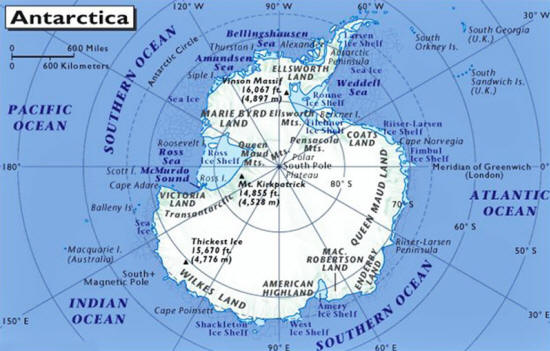
Antarctica map
"This is one of the
more extreme places where you could expect to find life. It's
even here," said Ross Powell, a Northern Illinois University
scientist who in January was using a remote-controlled submarine
deep under the ice in another part of Antarctica to figure out
about melting, when the unusual fish and shrimp-like creatures
swam by.
About 4,000 scientists
come to Antarctica for research during the summer and 1,000 stay in
the more forbidding winter.
There are also about
1,000 non-scientists - chefs, divers, mechanics, janitors and
the priest of the world's southernmost Eastern Orthodox Church on
top of a rocky hill at the Russian
Bellinghausen station.
But the church on the hill is an exception, a glimmer of the world
to the north.
For scientists, what
makes this place is the world below, which provides a window into
mankind's past and future.
"Antarctica in many
ways is like another planet," said Jose Retamales, the director
of the Chilean Antarctic Institute, while aboard a navy ship
cruising along Deception and the other South Shetland islands.
"It's a completely
different world."
|






